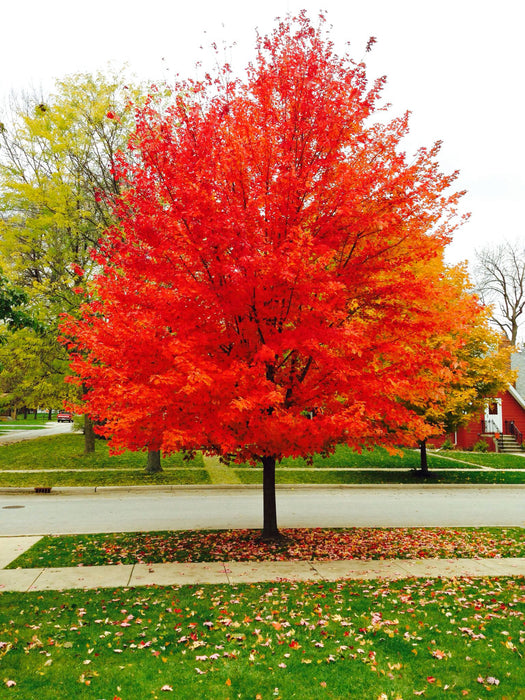The Stunning Red Sunset Maple Tree
The species that produced Acer rubrum ‘Franksred’ (Red Sunset Maple Tree) has populated North American landscapes for thousands of years. European botanists first documented Acer rubrum during the 17th century although Indigenous communities had previously held this species in high regard for spiritual reasons as well as its practical uses. Selective breeding developed the ‘Franksred’ cultivar in the mid-20th century for its brilliant foliage and robust structure which gained popularity among horticulturists and landscape designers. Literature, folklore, and natural history have recognized the tree as an emblem of enduring seasonal beauty over time.
Red Sunset Maple Tree Medical Uses Through the Ages
Traditional Native American and early settler practices established the medicinal use of Acer rubrum ‘Franksred’. People traditionally used the inner bark of the parent species to produce teas and poultices that helped treat sore throats along with fevers and digestive problems. The tree offered valuable treatment for wounds and skin irritations because of its astringent properties and its decoctions were sometimes used to alleviate inflammation. While contemporary medical practices have supplanted these traditional remedies, herbalists today still see Acer rubrum as a beneficial botanical for mild medicinal applications.
Discovery and Initial Uses
European explorers documented red maple trees, acer rubrum during their exploration of North America's large forested regions. The plant became well-known because of its brilliant seasonal colors and ability to thrive in different soil conditions. The wood from this tree helped early settlers produce tools and furniture along with basic medicinal products. The cultivar ‘Franksred’ emerged as an advanced version because of its stable deep foliage colors and better environmental stress resistance. Throughout the world arboretums and cultivated gardens continue to feature this species as an essential component.
Landscape Applications and Popularity
The Red Sunset Maple Tree cultivar becomes a focal point in both residential areas and commercial spaces. The combination of this tree’s remarkable beauty and toughness results in its widespread selection by city planners and residential owners. This tree grows well as a street tree because it can withstand pollution and dense soil conditions while providing shade for parks and large yards. The symmetrical form and brilliant autumn display of this tree make it highly valued among landscapers who use it to create fiery color displays across whole landscapes. This tree's moderate growth rate and manageable size enable strategic placement in formal gardens as well as naturalistic woodland edges.

The Distinct Appearance and Seasonal Transformation Of Red Sunset Maple Tree
Only a limited number of trees can match the stunning year-round transformation of Acer rubrum ‘Franksred’. During springtime this tree bursts into life with tiny red-tinged blooms that quietly signal the onset of warmer weather. The summer months transform the Acer rubrum ‘Franksred’ into a dense green canopy that delivers plenty of shade. The tree reaches its full potential in autumn when its leaves transform into breathtaking hues of crimson, orange, and gold. The vertical branching architecture gives this tree its visual charm by providing a majestic presence in any garden setting. The tree’s bare form stands out dramatically against the snowy landscape throughout winter and demonstrates its architectural elegance.
Rare Wildlife It Lures In
Red Sunset Maple Tree attracts many different wildlife species, especially rare and specialized ones. Native bees and butterflies require the nectar from this plant to sustain themselves during its flowering stage. Migratory songbirds find shelter under the tree's dense canopy while woodpeckers and nuthatches actively search for insects by pecking at the tree's bark. The seeds and tender twigs of this tree serve as food for mammals including squirrels and deer. The tree serves as a vital host plant for moth and butterfly larvae which solidifies its function in maintaining complex ecological networks.
Red Sunset Maple Tree A Testament to Hardiness
The defining characteristic of Acer rubrum ‘Franksred’ is its outstanding hardiness. The plant displays remarkable adaptability as it grows successfully in diverse soil conditions from moist lowland areas to drier upland regions. This cultivar survives cold winters and humid summers, which allows it to function well in different climatic conditions. The tree sustains its long life because of its robust root system combined with its ability to resist typical pests and diseases which lets mature trees live for multiple decades. This species maintains a strong presence both in cityscapes and untouched forests because it withstands drought and pollution while remaining resilient to environmental stressors.
The Red Sunset Maple Tree stands as one of the most valued and tough trees in landscaping because of its extraordinary attractiveness along with significant ecological advantages and historical importance. The tree's brilliant leaves and ability to attract wildlife combined with its durable nature establish it as an essential component of both public and private gardens.